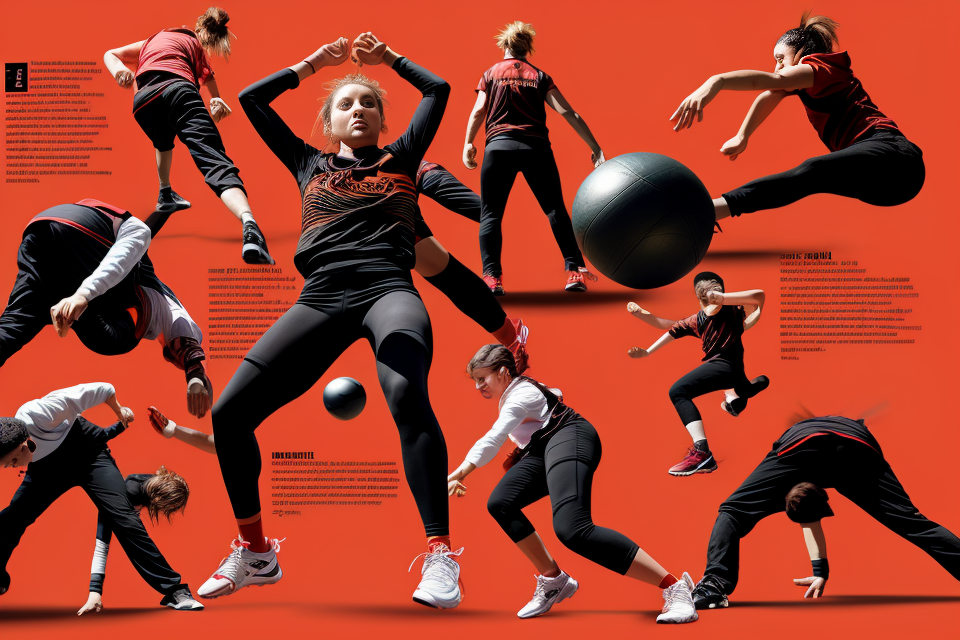The world of sports is constantly evolving, and with the rapid advancements in technology, it’s hard to predict what the future holds. But one thing is for sure, sports in 2050 will be vastly different from what we know today. From new technologies to changing social dynamics, the way we play, watch and engage with sports will be transformed. In this article, we’ll take a look at some of the potential changes that may shape the future of sports, and how they could impact the way we live and interact with each other. So buckle up and get ready for a glimpse into the exciting world of sports in 2050.
Technological Advancements
Enhanced Virtual Reality
Enhanced Virtual Reality (E
Advanced Wearable Technology
In the future, wearable technology will be much more advanced, offering athletes and sports enthusiasts a wide range of benefits. Here are some of the most significant advancements we can expect to see:
Real-time Performance Tracking
One of the most exciting developments in wearable technology is the ability to track an athlete’s performance in real-time. This includes tracking their heart rate, distance covered, calories burned, and other vital statistics. This data can be used to optimize training and improve overall performance.
Biometric Monitoring
Wearable technology will also be able to monitor an athlete’s biometric data, such as oxygen consumption, lactate threshold, and power output. This data can be used to personalize training programs and help athletes avoid injury.
Personalized Coaching and Nutrition
Advanced wearable technology will also enable personalized coaching and nutrition. By analyzing an athlete’s biometric data, coaches and nutritionists will be able to create customized training and nutrition plans that are tailored to the individual’s needs. This will help athletes reach their full potential and prevent injury.
Additionally, wearable technology will be able to track an athlete’s sleep patterns and provide personalized recommendations for improving sleep quality. This is essential for optimal performance, as sleep plays a crucial role in recovery and overall health.
Overall, advanced wearable technology will revolutionize the way we approach sports and fitness, providing athletes and enthusiasts with a wealth of data and personalized coaching to help them achieve their goals.
Artificial Intelligence in Sports
Predictive Analytics
- Predictive analytics involves the use of data and statistical models to forecast future outcomes in sports.
- This technology can help coaches and team managers make informed decisions on player recruitment, game strategy, and training programs.
- By analyzing historical data on player performance, predictive analytics can identify patterns and trends that can be used to predict future performance and improve team success.
Automated Coaching and Scouting
- Automated coaching and scouting involve the use of AI-powered tools to analyze player performance and provide feedback to coaches and players.
- These tools can automatically detect patterns in player movements, ball trajectories, and other aspects of the game to provide insights into player strengths and weaknesses.
- This can help coaches develop personalized training programs for players and identify areas for improvement, leading to better performance on the field.
Improved Player Safety and Fairness
- AI technology can be used to monitor player movements and identify potential injuries before they occur.
- This can help prevent injuries and reduce the risk of players being forced to leave the game due to injury.
- Additionally, AI can be used to detect and prevent unfair play, such as cheating or unsportsmanlike conduct, ensuring a fair and exciting game for all players.
Overall, the integration of AI in sports is poised to revolutionize the way we play and watch sports. By providing insights into player performance, predicting future outcomes, and ensuring fair play, AI technology has the potential to transform the sports industry in the coming years.
The Changing Landscape of Professional Sports
Globalization of Leagues
- Expansion into new markets
As professional sports leagues continue to expand their reach, they are entering new markets around the world. This has led to an increase in the number of fans and followers of these leagues, which in turn has led to increased revenue. For example, the National Football League (NFL) has seen significant growth in popularity in countries such as Mexico and Canada, leading to the establishment of the NFL International Series, which hosts regular season games in these countries. - Diversification of player pool
With the globalization of professional sports, there has been a significant increase in the diversity of players in these leagues. This has led to a more competitive and dynamic playing field, as players from different backgrounds and cultures bring their unique skills and experiences to the game. For example, the NBA has seen an influx of talented players from countries such as Nigeria, Serbia, and Australia, which has led to an increase in the overall level of play in the league. - Increased competition
The globalization of professional sports has also led to an increase in competition among teams and players. With more leagues entering new markets and attracting top talent from around the world, the level of competition has risen significantly. This has led to an increase in the quality of play and has made it more difficult for teams to win championships. For example, the English Premier League, which has long been considered one of the top soccer leagues in the world, now faces stiff competition from other leagues such as La Liga and the Bundesliga, which have also expanded their reach and attracted top talent from around the world.
E-Sports and Gaming
E-sports, a term that refers to competitive video gaming, has experienced a meteoric rise in popularity over the past decade. This has led to a growing recognition of e-sports as a legitimate form of professional sport.
- Rise of e-sports as a professional sport
E-sports tournaments now boast large prize pools, lucrative sponsorship deals, and dedicated fan bases. Professional gamers are treated like any other athlete, with training regimens, coaches, and agents. Even countries are beginning to take notice, with some nations forming national e-sports teams and hosting international competitions. - Integration of gaming and traditional sports
The lines between traditional sports and e-sports are becoming increasingly blurred. For example, the NBA has launched an e-sports league, while the English Premier League has partnered with FIFA to create an e-sports tournament. This integration of gaming and traditional sports creates new opportunities for collaboration and innovation. - Opportunities for non-traditional athletes
The rise of e-sports has also opened up new opportunities for non-traditional athletes. People with physical disabilities, for example, can now compete in e-sports tournaments, where their physical limitations are not a barrier to success. Additionally, e-sports provides opportunities for people from diverse backgrounds and cultures to participate in a global community of gamers.
As e-sports continues to grow in popularity, it is likely that we will see even more integration between gaming and traditional sports, as well as new opportunities for non-traditional athletes to participate in competitive sports.
Financial Sustainability
Revenue Generation through New Technologies
As technology continues to advance, professional sports are finding new and innovative ways to generate revenue. With the rise of digital media and social networking platforms, sports organizations are able to reach a wider audience and monetize their content in ways that were previously unimaginable. For example, live streaming services, virtual reality experiences, and immersive broadcasting are just a few of the technologies that are changing the way fans consume sports content. These new revenue streams not only provide a much-needed financial boost for sports organizations, but they also offer fans a more engaging and interactive experience.
Player Salary Structures and Contracts
As the financial stakes in professional sports continue to rise, so too do the salaries of top athletes. However, as the market becomes increasingly saturated with high-paid players, teams are looking for new ways to manage their payrolls. One potential solution is the use of performance-based contracts, which tie a player’s salary to their on-field performance. This not only incentivizes players to perform at their best, but it also helps teams manage their finances more effectively. Additionally, the rise of player empowerment movements and collective bargaining agreements is likely to have a significant impact on player contracts and salary structures in the coming years.
Impact on Smaller Sports and Leagues
As the financial stakes in professional sports continue to rise, smaller sports and leagues are struggling to keep up. Many of these organizations simply do not have the resources to compete with the bigger leagues, and as a result, they are struggling to attract top talent and maintain their financial sustainability. However, there are some potential solutions on the horizon. For example, the rise of esports and other alternative sports is providing a new avenue for smaller organizations to generate revenue and build their fan bases. Additionally, the development of new technologies and revenue streams is providing opportunities for smaller sports to reach new audiences and monetize their content in innovative ways. While the future is uncertain, there are reasons to be optimistic about the future of smaller sports and leagues in the coming years.
Sustainability and Social Responsibility in Sports
Environmental Initiatives
Reduction of Carbon Footprint
The sports industry is one of the largest contributors to carbon emissions, primarily due to transportation, energy consumption, and waste generation. To mitigate this impact, various initiatives have been proposed for reducing the carbon footprint of sports events and facilities.
- Carbon offsetting: Organizations can offset their carbon emissions by investing in renewable energy projects or purchasing carbon credits. This approach helps to neutralize the environmental impact of their activities.
- Energy-efficient technologies: The adoption of energy-efficient technologies, such as LED lighting and solar panels, can significantly reduce energy consumption in stadiums and sports facilities.
- Sustainable sourcing: The procurement of sustainable materials for sports equipment, uniforms, and merchandise can help to minimize the environmental impact of the industry.
Use of Renewable Energy Sources
Renewable energy sources, such as solar, wind, and geothermal power, offer a sustainable alternative to traditional fossil fuels. Integrating these sources into sports facilities can significantly reduce their carbon footprint and promote sustainability.
- Solar-powered stadiums: The installation of solar panels on stadium roofs or surrounding areas can generate clean energy, which can be used to power stadium operations and equipment.
- Wind turbines: Wind turbines can be installed at stadiums to generate renewable energy, particularly in areas with strong wind resources.
- Geothermal energy: Stadiums can be designed to take advantage of geothermal energy, which involves using the heat from the Earth to provide heating and cooling.
Sustainable Stadium Design and Construction
The design and construction of sustainable stadiums can significantly reduce their environmental impact and promote sustainability.
- Green roofs: Incorporating green roofs or living walls into stadium designs can help to reduce heat island effects, absorb rainwater, and provide habitats for local wildlife.
- Water-efficient technologies: The use of water-efficient fixtures, such as low-flow faucets and toilets, can help to conserve water and reduce water waste in stadiums.
- Sustainable materials: The use of sustainable building materials, such as recycled content, locally sourced materials, and low-impact construction techniques, can help to minimize the environmental impact of stadium construction.
By implementing these environmental initiatives, the sports industry can contribute to a more sustainable future and demonstrate its commitment to social responsibility.
Diversity, Equity, and Inclusion
In 2050, the world of sports will prioritize diversity, equity, and inclusion in all aspects of the industry. This will include increased representation of underrepresented groups, a focus on mental health and well-being, and education and community outreach programs.
Increased Representation of Underrepresented Groups
Sports organizations will actively seek out and recruit athletes from diverse backgrounds, including those from underrepresented communities. This will involve creating opportunities for individuals from different ethnic, racial, and socioeconomic backgrounds to participate in sports at all levels, from grassroots to professional.
Moreover, sports organizations will invest in programs that support the development of athletes from underrepresented communities, providing them with access to training, coaching, and other resources. This will help to create a more inclusive and diverse sports culture, where everyone has an equal opportunity to succeed.
Focus on Mental Health and Well-being
By 2050, mental health and well-being will be a top priority in the sports industry. Athletes will have access to comprehensive mental health support services, including counseling, therapy, and other resources. This will help to reduce the stigma associated with mental health issues and encourage athletes to prioritize their mental well-being.
Furthermore, sports organizations will implement policies and practices that promote a healthy work-life balance for athletes, recognizing the importance of mental health and well-being beyond the playing field. This will include providing resources for stress management, sleep hygiene, and other aspects of athlete well-being.
Education and Community Outreach Programs
In 2050, sports organizations will be more socially responsible and committed to giving back to their communities. This will involve developing education and community outreach programs that promote healthy lifestyles, positive values, and social responsibility.
Sports organizations will partner with schools, community organizations, and other stakeholders to create programs that inspire and empower young people to pursue their dreams and achieve their goals. These programs will emphasize the importance of education, leadership, and teamwork, while also promoting the values of diversity, equity, and inclusion.
Overall, the sports industry in 2050 will be more diverse, equitable, and inclusive, with a focus on mental health and well-being, and a commitment to social responsibility and community engagement.
The Future of Fan Engagement
Enhanced Fan Experience
Immersive technologies for remote attendance
- Virtual reality (VR) and augmented reality (AR) technology will revolutionize the way fans experience live sports events remotely.
- VR/AR headsets will provide a fully immersive experience, allowing fans to feel like they are actually at the game, with 360-degree views of the stadium and players.
- This will provide an unparalleled level of immersion and interaction for fans who cannot attend games in person.
Interactive match analysis and prediction
- Advances in data analytics and artificial intelligence will allow for real-time analysis of matches, providing fans with unprecedented insights into the game.
- Fans will be able to access a wealth of data on the game, including player performance, tactics, and statistics, in real-time.
- This will enable fans to make more informed predictions about the outcome of the game and engage in more meaningful conversations with other fans.
Enhanced social media and fan communities
- Social media platforms will continue to play a major role in sports fandom, with fans able to connect with other fans from around the world.
- Fan communities will become more integrated with sports, with fans able to share their opinions and engage with other fans in real-time.
- Social media platforms will also provide a space for fans to share their experiences and connect with other fans who share their interests.
The Future of Spectator Sports
In the year 2050, spectator sports will be transformed by new technologies that will revolutionize the way fans experience live events. Here are some of the changes we can expect to see:
Virtual reality and augmented reality experiences
Virtual reality (VR) and augmented reality (AR) technologies will be integrated into the spectator experience, allowing fans to feel like they are part of the action. This will include VR and AR headsets that will transport fans to different locations within the stadium, as well as to different stadiums around the world.
Personalized content and storytelling
Personalized content and storytelling will become more prevalent, with sports teams and leagues using data analytics to tailor content to individual fans. This will include personalized video highlights, in-depth player profiles, and interactive quizzes and games.
Increased focus on fan experience and engagement
The fan experience will be a top priority for sports teams and leagues, with a focus on creating immersive and interactive experiences that will keep fans engaged throughout the game. This will include everything from interactive displays and activities to special promotions and giveaways.
Additionally, sports teams and leagues will be more responsive to fan feedback, with a focus on improving the fan experience based on what fans want and need. This will include things like more comfortable seating, better food and beverage options, and more accessible stadium amenities.
Overall, the future of spectator sports is bright, with new technologies and innovations that will transform the way fans experience live events. By focusing on the fan experience and providing personalized content and storytelling, sports teams and leagues can ensure that they remain relevant and engaging for years to come.
The Impact on Society and Culture
Shifting Values and Priorities
As we move towards the year 2050, the values and priorities of society are shifting towards a greater emphasis on health and wellness. With advancements in technology and an increased awareness of the importance of physical and mental health, sports are expected to play a crucial role in promoting healthy lifestyles.
Increased Emphasis on Health and Wellness
The future of sports in 2050 will likely see a greater focus on promoting physical activity and healthy lifestyles. With the rise of chronic diseases and the growing burden of healthcare costs, there is a growing recognition of the importance of regular exercise and healthy habits. Sports will play a critical role in promoting physical activity and encouraging people to lead healthier lives.
Greater Focus on Mental Health and Well-being
In addition to physical health, mental health and well-being will also be a top priority in the future of sports. The stigma surrounding mental health issues is gradually diminishing, and there is a growing recognition of the importance of mental health in overall well-being. Sports can play a vital role in promoting mental health by providing opportunities for stress relief, socialization, and positive emotional experiences.
The Role of Sports in Fostering Social Connections
Finally, sports will continue to play a crucial role in fostering social connections and building communities. As people become more isolated due to technological advancements and changing lifestyles, sports can provide a platform for people to connect and build relationships. Through sports, individuals can develop a sense of belonging and identity, and create meaningful connections with others.
Changing Perceptions of Success
In the future, the way society perceives success in sports will undergo a significant transformation. Traditional metrics such as win-loss records will be complemented by new and more holistic ways of evaluating athletes and their achievements.
New metrics for success beyond traditional win-loss records
As sports become more competitive and technology continues to advance, traditional win-loss records will no longer be the sole measure of success. In their place, a variety of new metrics will emerge that take into account a wider range of factors, such as individual and team performance, physical and mental health, and social impact.
For example, advanced analytics will be used to evaluate the overall impact of a player’s performance on the game, including their ability to create scoring opportunities for their teammates, their defensive contributions, and their overall fitness and conditioning. This data will be used to create a more comprehensive picture of an athlete’s performance, one that goes beyond simple statistics like goals scored or assists made.
Holistic development of athletes and individuals
Along with new metrics for success, there will be a greater emphasis on the holistic development of athletes as individuals. This will involve not just physical training, but also mental and emotional development, as well as education and community engagement.
For instance, athletes will be encouraged to develop leadership skills, to become active and engaged members of their communities, and to use their platforms to promote social change. They will be seen not just as entertainers, but as role models and ambassadors for their sport and their communities.
Emphasis on personal growth and fulfillment
Finally, in the future of sports, success will be defined not just by on-field achievements, but by personal growth and fulfillment as well. Athletes will be encouraged to pursue their passions and interests beyond their sport, to explore new experiences and opportunities, and to build a well-rounded and fulfilling life for themselves.
This shift towards a more holistic view of success in sports will have a profound impact on society as a whole, encouraging individuals to pursue their passions and interests, to strive for personal growth and fulfillment, and to make a positive impact on the world around them.
FAQs
1. What technological advancements are expected to shape the future of sports in 2050?
Sports in 2050 will be significantly shaped by technological advancements such as virtual reality, artificial intelligence, and data analytics. These technologies will help create immersive fan experiences, enhance athlete performance, and improve the overall management of sports events. Virtual reality will allow fans to experience games from different perspectives, while artificial intelligence will help predict game outcomes and improve coaching strategies. Data analytics will help teams make data-driven decisions and improve their overall performance.
2. How will climate change impact sports in 2050?
Climate change is expected to have a significant impact on sports in 2050. Extreme weather conditions, such as heatwaves and heavy rainfall, will disrupt schedules and affect player safety. As a result, sports leagues will need to adapt by developing new rules and regulations to accommodate these conditions. Additionally, there may be a shift towards indoor sports or sports played in controlled environments to mitigate the effects of climate change.
3. How will the evolution of technology impact the role of sports in society?
The evolution of technology is expected to have a profound impact on the role of sports in society. Sports will become more accessible and inclusive, with virtual and augmented reality providing opportunities for people to participate in sports regardless of their physical abilities. Sports will also become more data-driven, with analytics playing a key role in team management and coaching. This will lead to a more objective and evidence-based approach to sports, which could potentially reduce the influence of biases and subjective opinions.
4. How will sports in 2050 address issues of fairness and cheating?
Sports in 2050 will need to address issues of fairness and cheating in new and innovative ways. With the increased use of technology in sports, there will be greater opportunities for cheating, such as the use of performance-enhancing drugs and advanced equipment. To address this, sports leagues will need to develop new methods of detection and deterrence, such as biometric testing and AI-powered surveillance. Additionally, there may be a shift towards more transparent and accountable systems of governance to ensure fairness and integrity in sports.
5. How will the evolution of sports impact the health and wellbeing of athletes?
The evolution of sports in 2050 will have a significant impact on the health and wellbeing of athletes. With the increasing use of technology in sports, there will be greater opportunities for injury prevention and recovery. For example, wearable technology will enable coaches and trainers to monitor an athlete’s movements and provide real-time feedback to prevent injuries. Additionally, advances in medical technology will enable more effective treatment of injuries and improved rehabilitation processes. However, there may also be new health risks associated with the use of advanced equipment and performance-enhancing technologies, which will need to be carefully managed and regulated.










